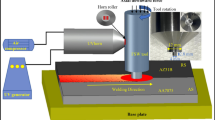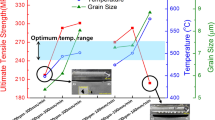Abstract
Friction stir welding (FSW) process has gained attention in recent years because of its advantages over the conventional fusion welding process. These advantages include the absence of heat formation in the affected zone and the absence of large distortion, porosity, oxidation, and cracking. Experimental investigations are necessary to understand the physical behavior that causes the high tensile strength of welded joints of different metals and alloys. Existing literature indicates that tensile properties exhibit strong dependence on the rotational speed, traverse speed, and axial force of the tool that was used. Therefore, this study introduces the experimental procedure for measuring tensile properties, namely, ultimate tensile strength (UTS) and tensile elongation of the welded AA 7020 Al alloy. Experimental findings suggest that a welded part with high UTS can be achieved at a lower heat input compared with the high heat input condition. A numerical approach based on genetic programming is employed to produce the functional relationships between tensile properties and the three inputs (rotational speed, traverse speed, and axial force) of the FSW process. The formulated models were validated based on the experimental data, using the statistical metrics. The effect of the three inputs on the tensile properties was investigated using 2D and 3D analyses. A high UTS was achieved, including a rotational speed of 1050 r/min and traverse speed of 95 mm/min. The results also indicate that 8 kN axial force should be set prior to the FSW process.
Similar content being viewed by others
References
Yazdipour A, Heidarzadeh A. Effect of friction stir welding on microstructure and mechanical properties of dissimilar Al 5083-H321 and 316L stainless steel alloy joints. Journal of Alloys and Compounds, 2016, 680: 595–603
Yazdipour A, Heidarzadeh A. Dissimilar butt friction stir welding of Al 5083-H321 and 316L stainless steel alloys. The International Journal of Advanced Manufacturing Technology, 2016, 1–8
Heidarzadeh A, Khodaverdizadeh H, Mahmoudi A, et al. Tensile behavior of friction stir welded AA 6061-T4 aluminum alloy joints. Materials & Design, 2012, 37: 166–173
Heidarzadeh A, Kazemi-Choobi K, Hanifian H, et al. 3-Microstructural evolution. In: Besharati-Givi MK, Asadi P, eds. Advances in Friction-Stir Welding and Processing. Woodhead Publishing, 2014, 65–140
Khodaverdizadeh H, Mahmoudi A, Heidarzadeh A, et al. Effect of friction stir welding (FSW) parameters on strain hardening behavior of pure copper joints. Materials & Design, 2012, 35: 330–334
Heidarzadeh A, Saeid T. A comparative study of microstructure and mechanical properties between friction stir welded single and double phase brass alloys. Materials Science and Engineering A, 2016, 649: 349–358
Heidarzadeh A, Saeid T. On the effect of β phase on the microstructure and mechanical properties of friction stir welded commercial brass alloys. Data in Brief, 2015, 5: 1022–1025
Heidarzadeh A, Saeid T. Correlation between process parameters, grain size and hardness of friction-stir-welded Cu-Zn alloys. Rare Metals, 2016, 1–11
Heidarzadeh A, Jabbari M, Esmaily M. Prediction of grain size and mechanical properties in friction stir welded pure copper joints using a thermal model. The International Journal of Advanced Manufacturing Technology, 2015, 77(9–12): 1819–1829
Golezani A S, Barenji R V, Heidarzadeh A, et al. Elucidating of tool rotational speed in friction stir welding of 7020-T6 aluminum alloy. International Journal of Advanced Manufacturing Technology, 2015, 81(5–8): 1155–1164
Rahimzadeh Ilkhichi A, Soufi R, Hussain G, et al. Establishing mathematical models to predict grain size and hardness of the friction stir-welded AA 7020 aluminum alloy joints. Metallurgical and Materials Transactions B, 2015, 46 (1): 357–365
Barenji R V. Influence of heat input conditions on microstructure evolution and mechanical properties of friction stir welded pure copper joints. Transactions of the Indian Institute of Metals, 2016, 69(5): 1077–1085
Garg A, Panda B, Shankhwar K. Investigation of the joint length of weldment of environmental-friendly magnetic pulse welding process. The International Journal of Advanced Manufacturing Technology, 2016, 1–12
Barenji R V. Effect of tool traverse speed on microstructure and mechanical performance of friction stir welded 7020 aluminum alloy. Proceedings of the Institution of Mechanical Engineers, Part L: Journal of Materials Design and Applications, 2015, 230(2): 1–11
Azizi A, Barenji R V, Barenji A V, et al. Microstructure and mechanical properties of friction stir welded thick pure copper plates. The International Journal of Advanced Manufacturing Technology, 2016, 1–11
Sharma V, Prakash U, Kumar B M. Surface composites by friction stir processing: A review. Journal of Materials Processing Technology, 2015, 224: 117–134
Rajakumar S, Muralidharan C, Balasubramanian V. Establishing empirical relationships to predict grain size and tensile strength of friction stir welded AA 6061-T6 aluminium alloy joints. Transactions of Nonferrous Metals Society of China, 2010, 20(10): 1863–1872
Babu S, Elangovan K, Balasubramanian V, et al. Optimizing friction stir welding parameters to maximize tensile strength of AA2219 aluminum alloy joints. Metals and Materials International, 2009, 15 (2): 321–330
Heidarzadeh A, Saeid T, Khodaverdizadeh H, et al. Establishing a mathematical model to predict the tensile strength of friction stir welded pure copper joints. Metallurgical and Materials Transactions B, Process Metallurgy and Materials Processing Science, 2013, 44 (1): 175–183
Lakshminarayanan A K, Balasubramanian V. Comparison of RSM with ANN in predicting tensile strength of friction stir welded AA7039 aluminium alloy joints. Transactions of Nonferrous Metals Society of China, 2009, 19(1): 9–18
Mohammadzadeh A, Azadbeh M, Namini S A. Densification and volumetric change during supersolidus liquid phase sintering of prealloyed brass Cu28Zn powder: modeling and optimization. Science of Sintering, 2014, 46(1): 23–35
Zhao D, Tian Q, Li Z, et al. A new stepwise and piecewise optimization approach for CO 2 pipeline. International Journal of Greenhouse Gas Control, 2016, 49: 192–200
Zhao D, Zhu Q, Dubbeldam J. Terminal sliding mode control for continuous stirred tank reactor. Chemical Engineering Research & Design, 2015, 94: 266–274
Zhao D, Ni W, Zhu Q. A framework of neural networks based consensus control for multiple robotic manipulators. Neurocomputing, 2014, 140: 8–18
Zhao D, Zhu Q, Li N, et al. Synchronized control with neuro-agents for leader—Follower based multiple robotic manipulators. Neurocomputing, 2014, 124: 149–161
Vijayaraghavan V, Garg A, Wong C H, et al. An integrated computational approach for determining the elastic properties of boron nitride nanotubes. International Journal of Mechanics and Materials in Design, 2015, 11(1): 1–14
Vijayaraghavan V, Castagne S. Computational model for predicting the effect of process parameters on surface characteristics of mass finished components. Engineering Computations, 2016, 33(3): 789–805
Garg A, Vijayaraghavan V, Wong C H, et al. Combined CI-MD approach in formulation of engineering moduli of single layer graphene sheet. Simulation Modelling Practice and Theory, 2014, 48: 93–111
Vijayaraghavan V, Castagne S. Sustainable manufacturing models for mass finishing process. The International Journal of Advanced Manufacturing Technology, 2015, 1–9
Vijayaraghavan V, Wong C H. Torsional characteristics of single walled carbon nanotube with water interactions by using molecular dynamics simulation. Nano-Micro Letters, 2014, 6(3): 268–279
Wong C H, Vijayaraghavan V. Nanomechanics of imperfectly straight single walled carbon nanotubes under axial compression by using molecular dynamics simulation. Computational Materials Science, 2012, 53(1): 268–277
Panda B N, Bahubalendruni M R, Biswal B B. A general regression neural network approach for the evaluation of compressive strength of FDM prototypes. Neural Computing & Applications, 2015, 26 (5): 1129–1136
Panda B N, Bahubalendruni M R, Biswal B B. Comparative evaluation of optimization algorithms at training of genetic programming for tensile strength prediction of FDM processed part. Procedia Materials Science, 2014, 5: 2250–2257
Panda B N, Babhubalendruni MR, Biswal B B, et al. Application of artificial intelligence methods to spot welding of commercial aluminum sheets (B.S. 1050). In: Das K N, Deep K, Pant M, et al. eds. Proceedings of Fourth International Conference on Soft Computing for Problem Solving. Springer, 2015, 21–32
Vijayaraghavan V, Garg A, Lam J S L, et al. Process characterisation of 3D-printed FDM components using improved evolutionary computational approach. International Journal of Advanced Manufacturing Technology, 2015, 78(5–8): 781–793
Garg A, Vijayaraghavan V, Wong C H, et al. An embedded simulation approach for modeling the thermal conductivity of 2D nanoscale material. Simulation Modelling Practice and Theory, 2014, 44: 1–13
Garg A, Tai K. Comparison of regression analysis, artificial neural network and genetic programming in handling the multicollinearity problem. In: Proceedings of 2012 International Conference on Modelling, Identification & Control (ICMIC). Wuhan: IEEE, 2012, 353–358
Asghari A, Gandomi A H. Ductility reduction factor and collapse mechanism evaluation of a new steel knee braced frame. Structure and Infrastructure Engineering: Maintenance, Management, Life-Cycle Design and Performance, 2016, 12(2): 239–255
Gandomi A H, Faramarzifar A, Rezaee P G, et al. New design equations for elastic modulus of concrete using multi expression programming. Journal of Civil Engineering and Management, 2015, 21(6): 761–774
Heidarzadeh A, Barenji R V, Esmaily M, et al. Tensile properties of friction stir welds of AA 7020 aluminum alloy. Transactions of the Indian Institute of Metals, 2015, 68(5): 757–767
Koza J R. Genetic Programming: On the Programming of Computers by Means of Natural Selection. Cambridge: MIT press, 1992
Vapnik V N. Statistical Learning Theory. New York: Wiley, 1998
Garg A, Lam J S L, Gao L. Energy conservation in manufacturing operations: Modelling the milling process by a new complexitybased evolutionary approach. Journal of Cleaner Production, 2015, 108: 34–45
Searson D P, Leahy D E, Willis M J. GPTIPS: An open source genetic programming toolbox for multigene symbolic regression. In: Proceedings of the International MultiConference of Engineers and Computer Scientists. Hong Kong: Newswood Ltd., 2010, 1: 77–80
Author information
Authors and Affiliations
Corresponding author
Rights and permissions
About this article
Cite this article
Panda, B., Garg, A., Jian, Z. et al. Characterization of the tensile properties of friction stir welded aluminum alloy joints based on axial force, traverse speed, and rotational speed. Front. Mech. Eng. 11, 289–298 (2016). https://doi.org/10.1007/s11465-016-0393-y
Received:
Accepted:
Published:
Issue Date:
DOI: https://doi.org/10.1007/s11465-016-0393-y




